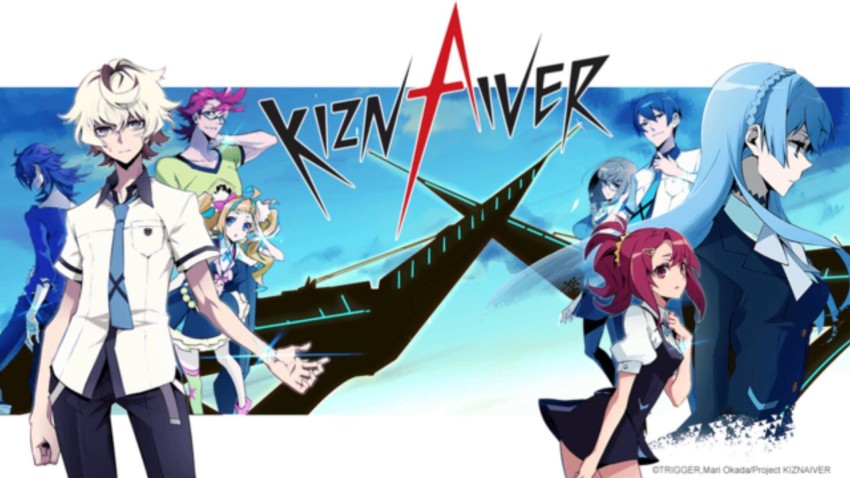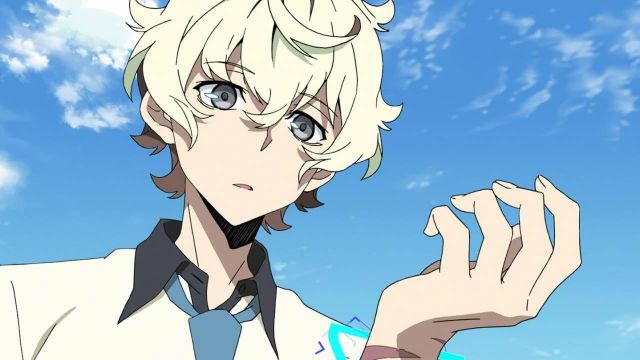Kiznaiver
March 13, 2019 · 0 comments
By Andrew Osmond.
 In the same way that Your Name will have viewers delving into the earlier films of Makoto Shinkai, and A Silent Voice draws attention to the work of Naoko Yamada and Kyoto Animation, so the release of Maquia will increase interest in the two-decade career of writer-director Mari Okada. We’ve posted an in-depth profile of Okada on this blog, while you can also read her life story in her own words. Now Anime Limited is releasing one of the last anime that Okada wrote before Maquia, though she didn’t direct it; it’s the 12-part TV series Kiznaiver.
In the same way that Your Name will have viewers delving into the earlier films of Makoto Shinkai, and A Silent Voice draws attention to the work of Naoko Yamada and Kyoto Animation, so the release of Maquia will increase interest in the two-decade career of writer-director Mari Okada. We’ve posted an in-depth profile of Okada on this blog, while you can also read her life story in her own words. Now Anime Limited is releasing one of the last anime that Okada wrote before Maquia, though she didn’t direct it; it’s the 12-part TV series Kiznaiver.
Kiznaiver, it’s quite clear when you start watching it, isn’t from the same side of Okada’s oeuvre as Maquia. It’s no mother and child story; instead it’s an ensemble drama about a group of teenagers, male and female, and the strange situation they’re in. But, like Maquia and many of Okada’s other anime, Kiznaiver’s an enormously emotional drama; the sharing of emotions is what it’s all about. The title is a play on three words: kizu (wound), kizuna (bond) and the English “naïve.”
It’s set in a shiny new Japanese city, Sugomori, whose youngsters lead normal-seeming lives. That’s until seven of them are suddenly abducted by the “Gomorin”, Disneyland-style costumed characters who are supposedly the city’s mascots. The teens are only passingly acquainted and seem to belong to different ‘types’ – the jock, the ditz, the ice queen and so on. They’re greeted in a control room by an impassive girl called Noriko, who tells them they’ve been selected for an experiment to curb human conflict.
One of the conditions that lets people fight, Noriko explains, is their lack of empathy; peopole can inflict pain on others without feeling that pain themselves. But the “Kizuna System” is an exercise in connecting pain. Each of the abducted youngsters has been operated on so that any pain felt by one is shared by all – a basis for communal harmony, at least in theory.Though as the series goes on, the kids starts sharing far more than just physical pain…
Several of Okada’s works before Maquia have involved ensembles of school-age youngsters, male and female, working through their feelings. The template goes back before Okada, and she conceived these shows together with other staff, but it seems to fit her skills. According to an unofficially translated interview, Okada first planned Kiznaiver as a “battle” series, but was steered by the director towards a youth drama. Perhaps he was thinking of the recent Okada-scripted Anthem of the Heart, a film in which four youngsters are thrown together to put on a music performance. Both Anthem and Kiznaiver focus on the most chronically repressed members of the groups.
 Whatever the creators intended, it’s possible to see Kiznaiver as less science-fiction than a self-aware riff on teen anime. It has comically obvious elements, such as a boy protagonist called Katsuhira who’s constantly helped and supported by a childhood friend who’s literally the girl next door, living in the apartment beside him. Chidori, as she’s called, is massively upset both by Katsuhira’s emotionless responses to her, and his clear fascination with the mysterious stranger, Noriko. Such rivalry is usually the stuff of sitcoms; in Kiznaiver, it’s far more painful.
Whatever the creators intended, it’s possible to see Kiznaiver as less science-fiction than a self-aware riff on teen anime. It has comically obvious elements, such as a boy protagonist called Katsuhira who’s constantly helped and supported by a childhood friend who’s literally the girl next door, living in the apartment beside him. Chidori, as she’s called, is massively upset both by Katsuhira’s emotionless responses to her, and his clear fascination with the mysterious stranger, Noriko. Such rivalry is usually the stuff of sitcoms; in Kiznaiver, it’s far more painful.
Kiznaiver also seems to be a “meta” story, a comment on stories, given one of its most interesting subplots. This involves another of the youngsters, the ice queen, called Mako. Eventually, we learn Mako was once a precocious manga writer, creating a melodrama with a close girl friend who deliberately stirred in “real” elements. One point the script makes is that story devices which fans may despise as melodrama do, after all, happen in real life too.
After a generally comedic first half, Kiznaiver becomes far more serious, with discussions about how the characters’ artificially-created bonds compare to ordinary human friendships. Which is the more authentic; which is the medicine and which the placebo? It’s tempting to read these discussions as also reflecting on commercial fictions about charismatic characters, like Kiznaver itself. Perhaps that’s why Kiznaiver, even without giant robots, has prominent echoes of the most “meta” anime of all, Evangelion. Sugomori could be twinned with Eva’s Tokyo-3, while the Kizuna System could be a riff on Human Instrumentality.
Or perhaps it’s all coincidence. Here’s another one: Kiznaiver was broadcast weeks before the release of Makoto Shinkai’s blockbusting Your Name, which again has teenagers being magically bonded, sharing bodies rather than pains or emotions…
Kiznaiver was made by Studio Trigger, which was by then famous for its manic Kill la Kill. Two of that show’s episodes were helmed by Kiznaiver’s director Hiroshi Kobayashi; beyond Trigger, he would storyboard Maquia for Okada. The Wikipedia entry for Kiznaiver tries linking it to Trigger’s other output, saying rather risibly that Trigger “deals with problems attributed to character interaction.” Actually, Kiznaiver’s colourful designs and visual humour, as well as its more serious underpinnings, are much closer to the two Gatchaman Crowds series directed by Kenji Nakamura ([C] Control) for a far older studio, Tatsunoko.
One of Kiznaiver’s most exuberant elements is also one of its most sombre. The show sports an opening titles sequence that, even by anime standards, is brilliantly psychedelic. The accompanying song, “Lay Your Hands on Me”, was created by an electronic music duo called Boom Boom Satellites, which supplied songs for the anime Xam’d and the film The Dark Knight.
“Lay Your Hands” would be the pair’s last song. Its guitarist/vocalist Michiyuki Kawashima had suffered from brain tumours for years, and endured extensive surgery; he died four months after Kiznaiver was broadcast, aged 47. It’s the kind of tragedy that, were it presented in a manga, would be exactly the kind of thing that a reader might dismiss as a clichéd melodrama. But as Kiznaiver itself notes, what we mock as melodrama can also be terribly real.
Andrew Osmond is the author of 100 Animated Feature Films.
Leave a Reply